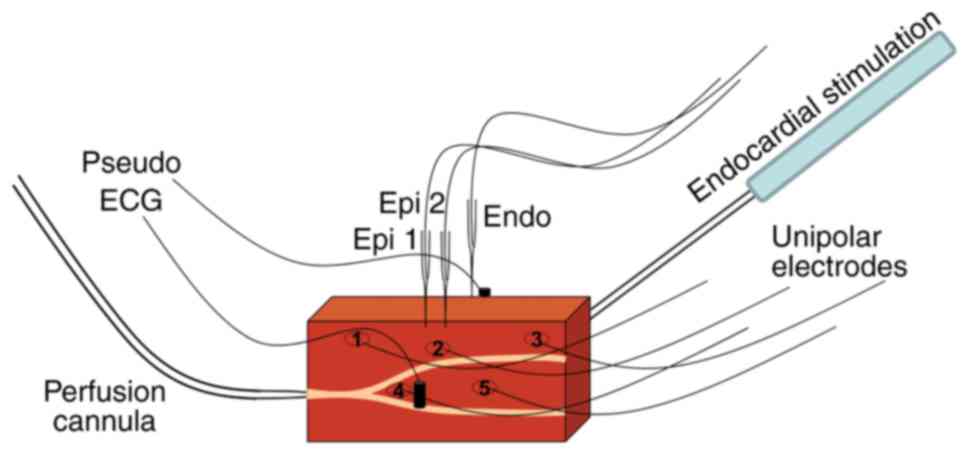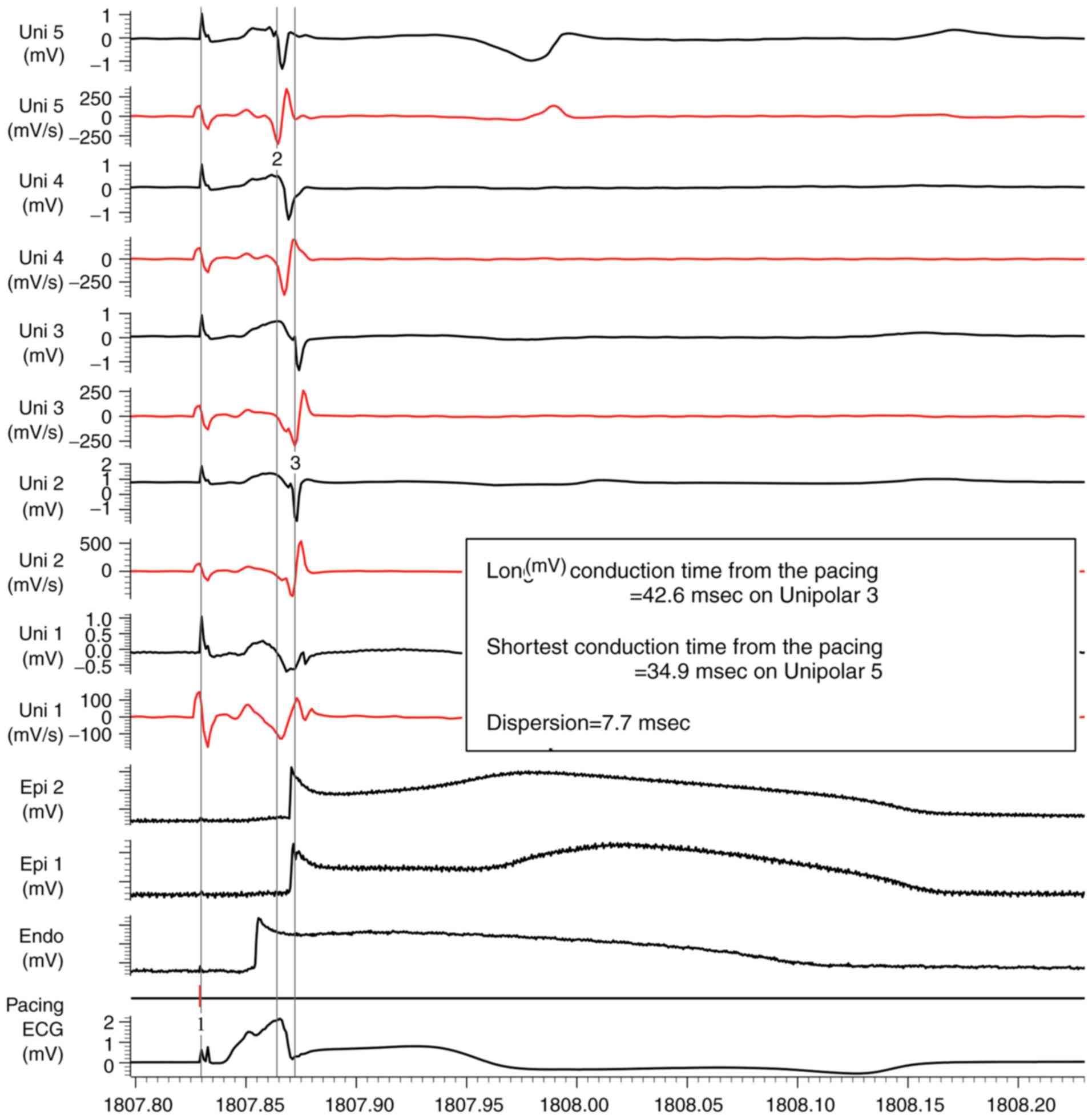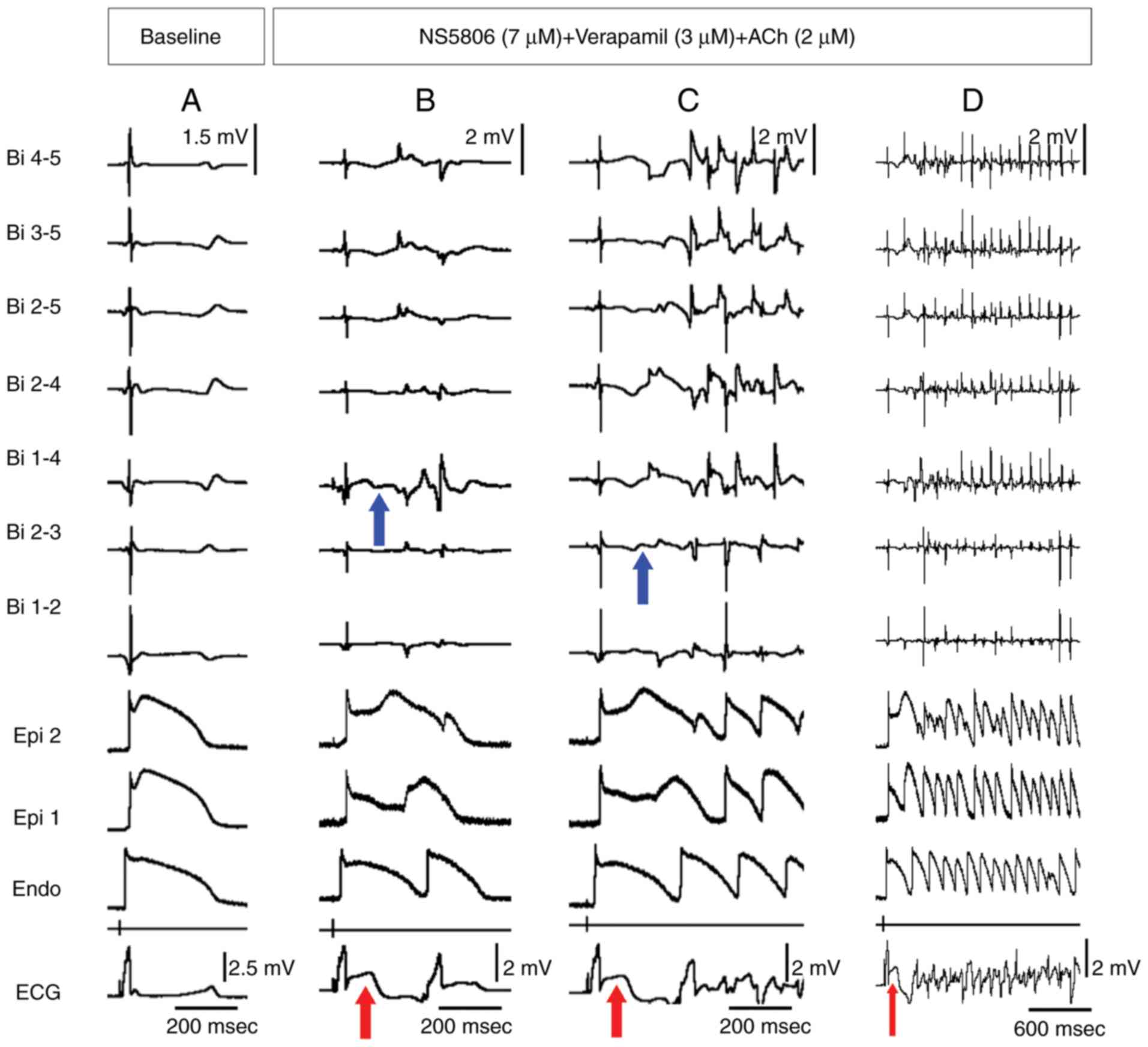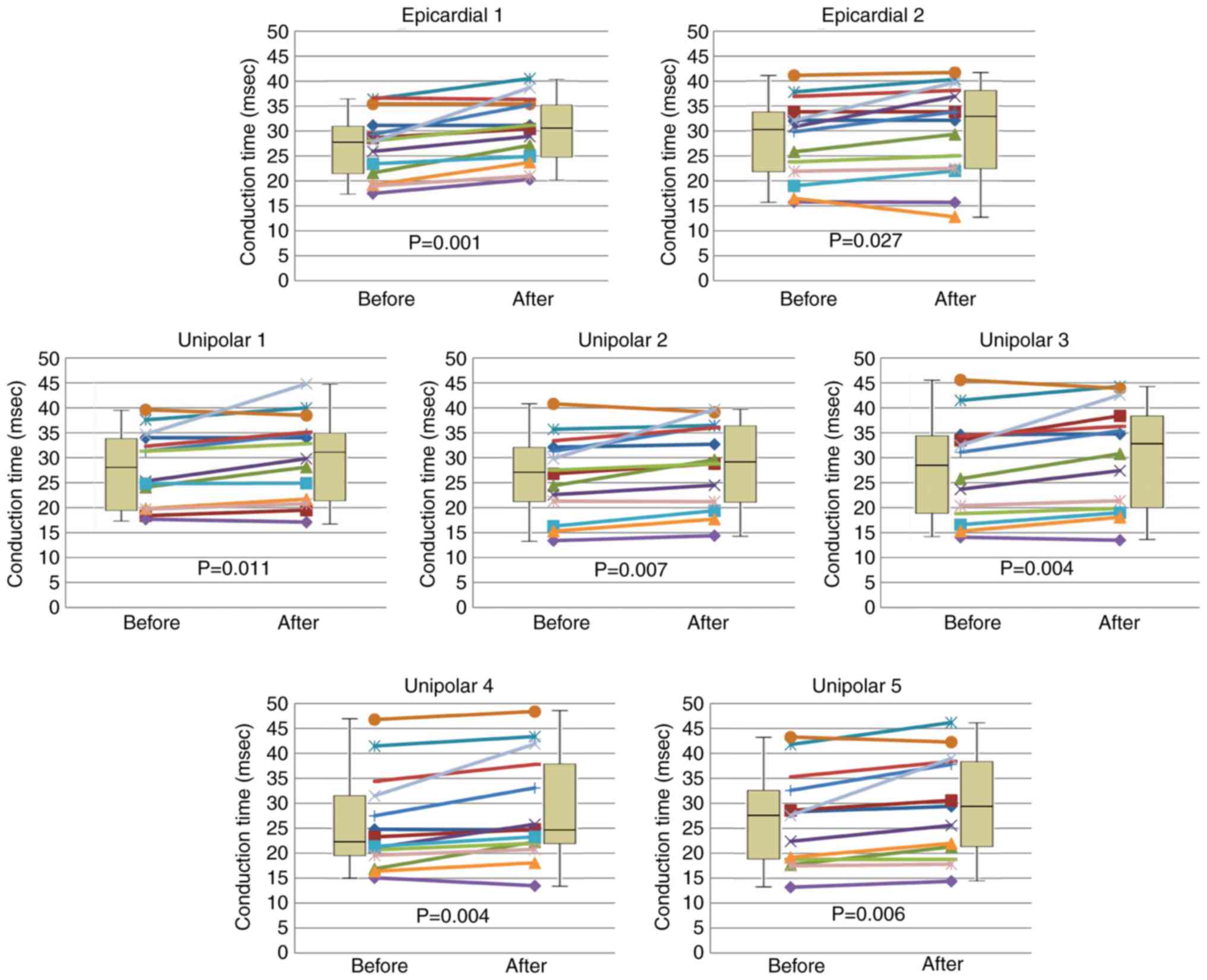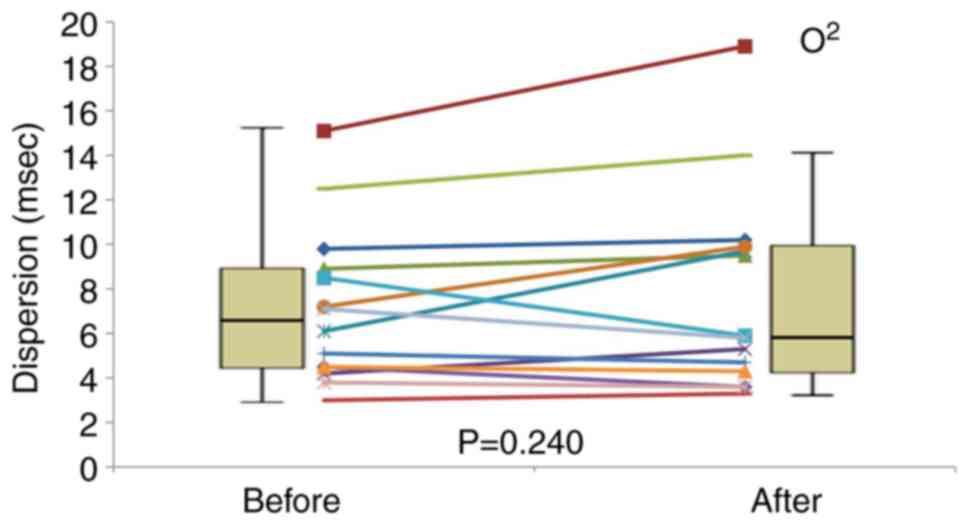|
1
|
Wasserburger RH and Alt WJ: The normal
RS-T segment elevation variant. Am J Cardiol. 8:184–192.
1961.PubMed/NCBI View Article : Google Scholar
|
|
2
|
Mehta MC and Jain AC: Early repolarization
on scalar electrocardiogram. Am J MedSci. 309:305–311.
1995.PubMed/NCBI View Article : Google Scholar
|
|
3
|
Gussak I and Antzelevitch C: Early
repolarization syndrome: Clinical characteristics and possible
cellular and ionic mechanisms. J Electrocardiol. 33:299–309.
2000.PubMed/NCBI View Article : Google Scholar
|
|
4
|
Antzelevitch C and Yan GX: J wave
syndromes. Heart Rhythm. 7:549–558. 2010.PubMed/NCBI View Article : Google Scholar
|
|
5
|
Haissaguerre M, Derval N, Sacher F, Jesel
L, Deisenhofer I, de Roy L, Pasquié JL, Nogami A, Babuty D,
Yli-Mayry S, et al: Sudden cardiac arrest associated with early
repolarization. N Engl J Med. 358:2016–2023. 2008.PubMed/NCBI View Article : Google Scholar
|
|
6
|
Nam GB, Kim YH and Antzelevitch C:
Augmentation of J waves and electrical storms in patients with
early repolarization. N Engl J Med. 358:2078–2079. 2008.PubMed/NCBI View Article : Google Scholar
|
|
7
|
Nam GB, Ko KH, Kim J, Park KM, Rhee KS,
Choi KJ, Kim YH and Antzelevitch C: Mode of onset of ventricular
fibrillation in patients with early repolarization pattern vs.
brugada syndrome. Eur Heart J. 31:330–339. 2010.PubMed/NCBI View Article : Google Scholar
|
|
8
|
Antzelevitch C: J wave syndromes:
Molecular and cellular mechanisms. J Electrocardiol. 46:510–518.
2013.PubMed/NCBI View Article : Google Scholar
|
|
9
|
Koncz I, Gurabi Z, Patocskai B, Panama BK,
Szél T, Hu D, Barajas-Martínez H and Antzelevitch C: Mechanisms
underlying the development of the electrocardiographic and
arrhythmic manifestations of early repolarization syndrome. J Mol
Cell Cardiol. 68:20–28. 2014.PubMed/NCBI View Article : Google Scholar
|
|
10
|
Hu D, Barajas-Martinez H, Terzic A, Park
S, Pfeiffer R, Burashnikov E, Wu Y, Borggrefe M, Veltmann C,
Schimpf R, et al: ABCC9 is a novel Brugada and early repolarization
syndrome susceptibility gene. Int J Cardiol. 171:431–442.
2014.PubMed/NCBI View Article : Google Scholar
|
|
11
|
Burashnikov E, Pfeiffer R,
Barajas-Martinez H, Delpón E, Hu D, Desai M, Borggrefe M,
Häissaguerre M, Kanter R, Pollevick GD, et al: Mutations in the
cardiac L-type calcium channel associated with inherited J-wave
syndromes and sudden cardiac death. Heart Rhythm. 7:1872–1882.
2010.PubMed/NCBI View Article : Google Scholar
|
|
12
|
Barajas-Martinez H, Hu D, Ferrer T, Onetti
CG, Wu Y, Burashnikov E, Boyle M, Surman T, Urrutia J, Veltmann C,
et al: Molecular genetic and functional association of brugada and
early repolarization syndromes with S422L missense mutation in
KCNJ8. Heart Rhythm. 9:548–555. 2012.PubMed/NCBI View Article : Google Scholar
|
|
13
|
Di Diego JM and Antzelevitch C:
Inferolateral J-wave syndromes: A reflection of abnormal
repolarization, depolarization, or both? Heart Rhythm. 16:791–792.
2019.PubMed/NCBI View Article : Google Scholar
|
|
14
|
Haissaguerre M, Nademanee K, Hocini M,
Cheniti G, Duchateau J, Frontera A, Sacher F, Derval N, Denis A,
Pambrun T, et al: Depolarization versus repolarization abnormality
underlying inferolateral J-wave syndromes: New concepts in sudden
cardiac death with apparently normal hearts. Heart Rhythm.
16:781–790. 2019.PubMed/NCBI View Article : Google Scholar
|
|
15
|
Veerakul G and Nademanee K: Brugada
syndrome: Two decades of progress. Circ J. 76:2713–2722.
2012.PubMed/NCBI View Article : Google Scholar
|
|
16
|
Fish JM, Welchons DR, Kim YS, Lee SH, Ho
WK and Antzelevitch C: Dimethyl lithospermate B, an extract of
danshen, suppresses arrhythmogenesis associated with the brugada
syndrome. Circulation. 113:1393–1400. 2006.PubMed/NCBI View Article : Google Scholar
|
|
17
|
Di Diego JM, Sicouri S, Myles RC, Burton
FL, Smith GL and Antzelevitch C: Optical and electrical recordings
from isolated coronary-perfused ventricular wedge preparations. J
Mol Cell Cardiol. 54:53–64. 2013.PubMed/NCBI View Article : Google Scholar
|
|
18
|
Watanabe H, Nogami A, Ohkubo K, Kawata H,
Hayashi Y, Ishikawa T, Makiyama T, Nagao S, Yagihara N, Takehara N,
et al: Electrocardiographic characteristics and SCN5A mutations in
idiopathic ventricular fibrillation associated with early
repolarization. Circ Arrhythm Electrophysiol. 4:874–881.
2011.PubMed/NCBI View Article : Google Scholar
|
|
19
|
Mizumaki K, Nishida K, Iwamoto J, Nakatani
Y, Yamaguchi Y, Sakamoto T, Tsuneda T, Kataoka N and Inoue H: Vagal
activity modulates spontaneous augmentation of J-wave elevation in
patients with idiopathic ventricular fibrillation. Heart Rhythm.
9:249–255. 2012.PubMed/NCBI View Article : Google Scholar
|
|
20
|
Wilhelm M, Brem MH, Rost C, Klinghammer L,
Hennig FF, Daniel WG and Flachskampf F: Early repolarization, left
ventricular diastolic function, and left atrial size in
professional soccer players. Am J Cardiol. 106:569–574.
2010.PubMed/NCBI View Article : Google Scholar
|
|
21
|
Marcus RR, Kalisetti D, Raxwal V, Kiratli
BJ, Myers J, Perkash I and Froelicher VF: Early repolarization in
patients with spinal cord injury: Prevalence and clinical
significance. J Spinal CordMed. 25:33–38. 2002.PubMed/NCBI View Article : Google Scholar
|
|
22
|
Koutbi L, Roussel M, Haissaguerre M and
Deharo JC: Hyperpnea test triggering malignant ventricular
arrhythmia in a child with early repolarization. Heart Rhythm.
9:1153–1156. 2012.PubMed/NCBI View Article : Google Scholar
|
|
23
|
Kawata H, Noda T, Yamada Y, Okamura H,
Satomi K, Aiba T, Takaki H, Aihara N, Isobe M, Kamakura S and
Shimizu W: Effect of sodium-channel blockade on early
repolarization in inferior/lateral leads in patients with
idiopathic ventricular fibrillation and brugada syndrome. Heart
Rhythm. 9:77–83. 2012.PubMed/NCBI View Article : Google Scholar
|
|
24
|
Kasanuki H, Ohnishi S, Ohtuka M, Matsuda
N, Nirei T, Isogai R, Shoda M, Toyoshima Y and Hosoda S: Idiopathic
ventricular fibrillation induced with vagal activity in patients
without obvious heart disease. Circulation. 95:2277–2285.
1997.PubMed/NCBI View Article : Google Scholar
|
|
25
|
Meregalli PG, Wilde AA and Tan HL:
Pathophysiological mechanisms of brugada syndrome: Depolarization
disorder, repolarization disorder, or more? Cardiovasc Res.
67:367–378. 2005.PubMed/NCBI View Article : Google Scholar
|
|
26
|
Wilde AA, Postema PG, Di Diego JM, Viskin
S, Morita H, Fish JM and Antzelevitch C: The pathophysiological
mechanism underlying brugada syndrome: Depolarization versus
repolarization. J Mol Cell Cardiol. 49:543–553. 2010.PubMed/NCBI View Article : Google Scholar
|
|
27
|
Di Diego JM, Argenziano M, Chen K, Tabler
M and Antzelevitch C: In a whole-heart model of the brugada
syndrome, delayed conduction in the RVOT ‘does not’ contribute to
inscription of the electrocardiographic J wave/ST segment
elevation. Heart Rhythm. 15(242)2018.
|
|
28
|
Yoon N, Hong SN, Cho JG, Jeong HK, Lee KH
and Park HW: Experimental verification of the value of the
Tpeak-Tend interval in ventricular arrhythmia
inducibility in an early repolarization syndrome model. J
Cardiovasc Electrophysiol. 30:2098–2105. 2019.PubMed/NCBI View Article : Google Scholar
|
|
29
|
Antzelevitch C, Yan GX and Shimizu W:
Transmural dispersion of repolarization and arrhythmogenicity: The
brugada syndrome versus the long QT syndrome. J Electrocardiol.
32:158–165. 1999.PubMed/NCBI View Article : Google Scholar
|
|
30
|
Maoz A, Christini DJ and Krogh-Madsen T:
Dependence of phase-2 reentry and repolarization dispersion on
epicardial and transmural ionic heterogeneity: A simulation study.
Europace. 16:458–465. 2014.PubMed/NCBI View Article : Google Scholar
|
|
31
|
Sims JJ, Miller AW and Ujhelyi MR:
Electrical heterogeneity and arrhythmogenesis: Importance of
conduction velocity dispersion. J Cardiovasc Pharmacol. 41:795–803.
2003.PubMed/NCBI View Article : Google Scholar
|
|
32
|
Srinivasan NT, Orini M, Providencia R,
Simon R, Lowe M, Segal OR, Chow AW, Schilling RJ, Hunter RJ,
Taggart P and Lambiase PD: Differences in the upslope of the
precordial body surface ECG T wave reflect right to left dispersion
of repolarization in the intact human heart. Heart Rhythm.
16:943–951. 2019.PubMed/NCBI View Article : Google Scholar
|
|
33
|
Malik M, Huikuri HV, Lombardi F, Schmidt
G, Verrier RL and Zabel M: e-Rhythm Group of EHRA. Is the
Tpeak-Tend interval as a measure of
repolarization heterogeneity dead or just seriously wounded? Heart
Rhythm. 16:952–953. 2019.PubMed/NCBI View Article : Google Scholar
|
|
34
|
Antzelevitch C and Di Diego JM: Reply to
the editor-Tpeak-Tend is alive and well.
Heart Rhythm. 16:e49–e50. 2019.PubMed/NCBI View Article : Google Scholar
|
|
35
|
Antzelevitch C and Di Diego JM:
Tpeak-Tend interval as a marker of arrhythmic
risk. Heart Rhythm. 16:954–955. 2019.PubMed/NCBI View Article : Google Scholar
|
|
36
|
Patocskai B, Barajas-Martinez H, Hu D,
Gurabi Z, Koncz I and Antzelevitch C: Cellular and ionic mechanisms
underlying the effects of cilostazol, milrinone, and isoproterenol
to suppress arrhythmogenesis in an experimental model of early
repolarization syndrome. Heart Rhythm. 13:1326–1334.
2016.PubMed/NCBI View Article : Google Scholar
|
|
37
|
Yoon N, Hong SN, Lee KH, Park HW and Cho
JG: Antiarrhythmic effect of artemisinin in brugada syndrome model.
Europace. 20(i138)2018.
|
|
38
|
Clark JD, Gebhart GF, Gonder JC, Keeling
ME and Kohn DF: Special report: The 1996 guide for the care and use
of laboratory animals. ILAR J. 38:41–48. 1997.PubMed/NCBI View Article : Google Scholar
|















